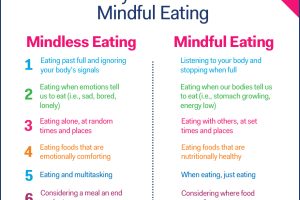Achieving Balance: Mindful Eating Strategies for Fresh Healthy Living

Mindful eating is gaining traction as people seek healthier lifestyles and deeper connections with their food. This growing curiosity often leads individuals to explore how the way they eat can influence their physical and emotional well-being.
- Achieving Balance: Mindful Eating Strategies for Fresh Healthy Living
- A Personal Journey into Mindful Eating
- Understanding Mindful Eating
- What is Mindful Eating?
- Benefits of Mindful Eating
- The Connection Between Mindful Eating and Healthy Living
- Impact of Mindful Eating on Overall Health
- Relationship Between Food Choices and Well-being
- Principles of Mindful Eating
- Eating with Intention
- Honoring Hunger and Fullness Cues
- Developing a Mindful Eating Practice
- Tips for Implementing Mindful Eating
- Overcoming Common Challenges
- Mindful Eating for Weight Management
- Mindful Eating vs. Dieting
- Sustaining Healthy Habits
- Mindful Eating in Different Cultures
- Cultural Influences on Eating Behaviors
- Adapting Mindful Eating to Cultural Norms
- Mindful Eating and Emotional Well-being
- Coping with Emotional Eating
- Improving Body Image through Mindful Eating
- Mindful Eating in Daily Life
- Incorporating Mindfulness into Meals
- Mindful Snacking Habits
- Mindful Eating for Families
- Teaching Children Mindful Eating
- Promoting Healthy Relationships with Food
- Mindful Eating Resources
- Books and Websites for Further Reading
- Apps for Mindful Eating Support
A Personal Journey into Mindful Eating
For many, the journey towards mindful eating begins with a moment of realization—perhaps after finishing a meal without really tasting it or feeling unsatisfied even after eating.
- Have you ever rushed through lunch while working?
- Do you often eat while watching TV?
These experiences highlight a common trend: eating on autopilot. Embracing mindful eating encourages individuals to slow down and appreciate every bite, fostering greater satisfaction and healthier choices. As we delve deeper into mindful eating, we will uncover its principles, the connection to health, and how to cultivate this practice into daily routines. It’s time to transform our relationship with food for a more fulfilling life.
Understanding Mindful Eating
Having set the stage for mindful eating, it’s essential to explore what this practice entails and the myriad benefits it offers.
What is Mindful Eating?
At its core, mindful eating is about being fully present during meals. It involves paying attention to the food, enjoying the flavors, and tuning in to the body’s hunger and fullness cues. This can mean taking a moment to appreciate the meal before diving in, eliminating distractions, and savoring each bite.
Benefits of Mindful Eating
The rewards of adopting mindful eating are plentiful:
- Improved Digestion: Slowing down allows the digestive system to function more efficiently.
- Enhanced Satisfaction: Savoring food leads to greater enjoyment and often reduces cravings.
- Healthier Choices: Being mindful helps individuals make better food selections, ultimately supporting weight management.
By embracing mindful eating, individuals can cultivate a healthier relationship with food, fostering emotional well-being alongside physical health.
The Connection Between Mindful Eating and Healthy Living
Building on the foundation of mindful eating, it’s important to understand how this practice intertwines with healthy living and overall well-being.
Impact of Mindful Eating on Overall Health
Mindful eating extends far beyond the dining table; it has a profound impact on physical health. By being conscious of food choices and portion sizes, individuals often notice several benefits:
- Reduced Stress Levels: Taking time to enjoy meals can decrease stress, promoting a sense of relaxation.
- Better Weight Management: Thoughtful eating can lead to natural weight loss or maintenance. Many find they eat less while feeling more satisfied.
Relationship Between Food Choices and Well-being
The foods we choose play a significant role in our mental and physical health. Mindful eating encourages:
- Whole Foods: Opting for fresh fruits and vegetables over processed snacks not only nourishes the body but also boosts mood.
- Balanced Nutrition: Being aware of what we eat leads to more balanced meals, supporting overall well-being.
By fostering this connection, mindful eating not only promotes a healthier lifestyle but also enhances daily life experiences.
Principles of Mindful Eating
Having explored the connection between mindful eating and healthy living, it’s now time to delve into the core principles that guide this practice.
Eating with Intention
Eating with intention means approaching meals with purpose. Instead of mindlessly grabbing a snack out of habit, it encourages individuals to choose foods that nourish not just the body but also the spirit. For example:
- Prepare Your Plate: Take a moment to arrange your food thoughtfully, making the meal visually appealing.
- Savor the Flavors: Focus on the tastes and textures instead of distractions like screens.
This intentionality transforms eating from a routine into a fulfilling experience.
Honoring Hunger and Fullness Cues
Listening to the body is crucial in practice. Honoring hunger means recognizing when to eat and, equally important, when to stop. Some simple practices include:
- Check-In Before Eating: Ask yourself if you’re truly hungry or eating out of boredom.
- Pause During Meals: Put down your fork and assess your fullness; this helps prevent overeating.
These principles collectively foster a nourishing and satisfying relationship with food, allowing individuals to connect more deeply with their eating habits.
Developing a Mindful Eating Practice
As we delve deeper into building a mindful eating practice, it’s empowering to remember that small shifts in approach can make a big impact on our relationship with food.
Tips for Implementing Mindful Eating
To start incorporating mindful eating into daily life, consider these practical tips:
- Create a Calm Environment: Set the table and eliminate distractions like phones and TV during meals.
- Slow Down: Try to extend meal times by chewing thoroughly and pausing between bites to savor flavors.
- Use All Five Senses: Engage with food fully—notice the colors, smells, and textures before tasting.
Overcoming Common Challenges
While the journey to mindful eating may be rewarding, some common challenges can arise, such as:
- Busy Lifestyles: Prioritize meal prep by dedicating a few hours weekly to cook and plan healthy meals.
- Peer Pressure: Communicate your mindful eating goals with friends or family, fostering support and understanding.
By embracing these tips and addressing challenges head-on, developing a mindful eating practice becomes more achievable, paving the way for a healthier and more intentional relationship with food.
Mindful Eating for Weight Management
Transitioning from the practical aspects of developing a mindful eating practice, it’s crucial to understand how this approach can significantly impact weight management.
Mindful Eating vs. Dieting
While traditional dieting often focuses on strict rules and calorie counting, mindful eating encourages a more holistic approach. With mindful eating:
- Flexibility is Key: You learn to listen to your body’s needs rather than adhere to arbitrary limits.
- Improved Satisfaction: Eating mindfully often leads to greater fullness and more contentment, reducing the likelihood of binge eating—a common issue with restrictive diets.
In essence, mindful eating offers a sustainable alternative to dieting, promoting a healthier mindset toward food.
Sustaining Healthy Habits
To sustain healthy habits through mindful eating, consider these strategies:
- Set Realistic Goals: Aim for gradual changes in eating patterns that feel manageable.
- Practice Self-Compassion: Acknowledge that slips are normal; it’s part of the learning process.
By integrating mindful eating into daily life, individuals can achieve lasting weight management while fostering a positive relationship with food, ultimately enhancing overall well-being.
Mindful Eating in Different Cultures
As we explore the global landscape of mindful eating, it’s fascinating to see how cultural influences shape our eating behaviors and practices.
Cultural Influences on Eating Behaviors
Food practices are deeply embedded in cultural traditions, impacting how and what we eat. For example:
- Celebratory Meals: In many cultures, food is central to celebrations, often leading to communal eating experiences that foster connection.
- Rituals and Traditions: Certain cultures have rituals that promote mindfulness, such as slow, deliberate meals during religious observances.
These influences highlight how culture can enhance our relationship with food, offering opportunities for mindfulness.
Adapting Mindful Eating to Cultural Norms
To successfully integrate mindful eating within cultural contexts, consider these points:
- Incorporate Tradition: Use cultural recipes while practicing mindfulness, allowing for appreciation of both the food and its origins.
- Shared Experiences: Engage in communal meals with mindfulness, creating spaces for conversation and connection.
By adapting mindful eating to cultural norms, individuals can enhance their culinary experiences while respecting and honoring their heritage, leading to a richer and more meaningful relationship with food.
Mindful Eating and Emotional Well-being
Transitioning into the realm of emotional well-being, it’s essential to understand how mindful eating can serve as a powerful tool for coping with emotional challenges related to food.
Coping with Emotional Eating
Many individuals find comfort in food during stressful times, leading to emotional eating. Mindful eating offers an alternative approach:
- Pause Before Eating: Take a moment to assess your feelings before reaching for food. Are you hungry, or are you seeking comfort?
- Choose Nourishing Options: Instead of indulging in mindless snacks, opt for foods that genuinely nourish you, both physically and emotionally.
These small shifts can help break the cycle of emotional eating.
Improving Body Image through Mindful Eating
Mindful eating can also enhance body image by promoting a more compassionate view of oneself. Consider these strategies:
- Focus on What Your Body Needs: Shift the perspective from aesthetics to health and nourishment, celebrating what your body can do.
- Practice Gratitude: Regularly express gratitude for your body and its strengths, reinforcing positive body image.
By incorporating these practices, individuals can foster emotional well-being, enhancing their connection with food and body.
Mindful Eating in Daily Life
With an understanding of the emotional benefits of mindful eating, let’s explore how to seamlessly incorporate mindfulness into everyday meals and snacking habits.
Incorporating Mindfulness into Meals
Transforming regular meals into mindful experiences can significantly enrich your relationship with food. Here are some practical tips:
- Set the Scene: Create a calm dining atmosphere by dimming the lights or playing soft music.
- Engage All Senses: Before you eat, take a moment to appreciate the aroma, color, and texture of your food—this enhances appreciation.
Taking these steps can turn an ordinary meal into a special ritual.
Mindful Snacking Habits
Snacking can often be mindless, but it doesn’t have to be. To cultivate mindfulness during snack time:
- Pre-Portion Snacks: Instead of eating straight from the bag, serve yourself a small portion to help avoid overeating.
- Savor Every Bite: Focus on tasting each bite and notice how different flavors combine.
By implementing these mindful practices in daily life, individuals can cultivate healthier eating habits and enhance their overall well-being.
Mindful Eating for Families
Expanding mindful eating practices to families can create an enriching environment that nurtures healthy relationships with food from an early age.
Teaching Children Mindful Eating
Introducing children to mindful eating can set the foundation for lifelong healthy habits. Here are some engaging ways to do this:
- Make it Fun: Turn meals into interactive experiences. Let children help with meal preparation, encouraging them to discover flavors and textures.
- Practice Gratitude: Before meals, take a moment as a family to express gratitude for the food, prompting children to appreciate what they eat.
These simple practices instill mindfulness in children and foster joy around eating.
Promoting Healthy Relationships with Food
Creating a positive food environment is essential for families:
- Avoid Labeling Foods: Instead of categorizing foods as “good” or “bad,” encourage balance and moderation, helping children develop a healthy mindset around food.
- Share Family Meals: Dine together as often as possible, providing opportunities for meaningful conversations and connections over food.
By cultivating mindful eating habits within the family, parents can greatly influence their children’s relationship with food, promoting healthier choices and emotional well-being.
Mindful Eating Resources
After exploring mindful eating practices for families, it’s important to equip yourself with additional resources to deepen your understanding and enthusiasm for this approach.
Books and Websites for Further Reading
There are numerous insightful books and websites dedicated to mindful eating. Here are a few recommended reads:
- “Mindful Eating: A Guide to Rediscovering a Healthy and Joyful Relationship with Food” by Jan Chozen Bays: This book offers practical exercises to explore and enhance your eating habits.
- Mindful Eating Institute: A comprehensive website featuring articles, courses, and workshops that delve into the principles of mindful eating.
These resources can provide valuable insights and guidance on your mindful eating journey.
Apps for Mindful Eating Support
To bring mindfulness into your daily routine, consider these helpful apps:
- Headspace: While primarily a meditation app, it has dedicated mindful eating modules that can enhance your practice.
- Eat Right Now: This app focuses on breaking the cycle of emotional eating through mindfulness techniques.
Utilizing these resources can significantly enrich your mindful eating experience, ensuring that your journey toward a healthier relationship with food is engaging and impactful.





